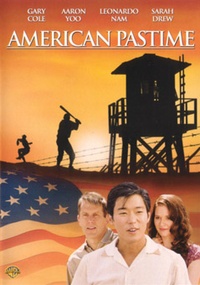“I really feel the power of our film is with an audience,” says Kerry Yo Nakagawa, associate producer of the new film American Pastime. “It has been amazing to sit with audiences and take the emotional roller coaster of a ride and hear the laughter, feel the tension and experience the sobbing and crying.”
For Nakagawa and others who worked on the project, making the film has been a deeply personal journey.
“Five years ago American Pastime was just an idea that came while our producer Barry Rosenbush was driving on the 405 Freeway while hearing me on a radio program,” Nakagawa says. “Now we are in ‘phase four’ with distribution and marketing of our DVD. I think all of us among the crew and cast felt this ‘anointment’ to tell a powerful American story of internment from the inside looking out.”
The dramatic film, set in Utah’s infamous Topaz concentration camp during World War II, depicts young Japanese Americans who turned to baseball as a way of dealing with their unjust incarceration.
“We all had different family legacies that were molded into the script,” says Nakagawa. “(The film’s writer-director) Desmond Nakano comes from a family of artists, musicians and dancers. His dad was in the 442nd Regimental Combat Team and his mom was interned at Amache, Colorado. My family’s legacy is tied to baseball and having uncles who competed with Gehrig, Ruth, O’Doul, Jackie Robinson, and my family ended up in camp in Jerome, Arkansas. Barry’s grandparents had to deal with the Holocaust. We all had personal stakes to educate, entertain and to inspire.”
“Desmond finished the script and it went through numerous rewrites,” Nakagawa recalls. “I remember reading the final polish and at the end crying with joy as the story circle closed.”
Nakagawa, who authored the 2001 nonfiction book Through a Diamond: 100 Years of Japanese American Baseball, worked hard with his fellow filmmakers to ensure that American Pastime was historically correct, incorporating archival footage and images from period. But from the beginning they knew that the project wasn't going to be an easy sell.
“Once it was ready, our script was sent around to all the studios and stars,” says Nakagawa. “The reaction to the writing was fantastic, but the subject matter was considered very obscure and a hidden legacy, so many passed on it. Luckily T&C Pictures in Japan put up the funding. So we cast in Los Angeles and Salt Lake City and then headed to the Skull Valley desert in Utah for 45 days to make our utopian film.”
In the harsh desert conditions, production was grueling, but Nakagawa notes that it was filled with poignant experiences both on and off-screen.
“On the set during filming, my son and I were part of the scene when the character of Lane goes off to war, with his well wishers surrounding him, and his mom and dad have to say goodbye,” Nakagawa says. “I felt my grandma’s spirit very strongly that day. She died in the Jerome, Arkansas, camp and never made it back to her restaurant in Fresno. It was like watching my parents say goodbye to her.”
In another instance, Nakagawa recounts a moving moment when elderly World War II veteran John Iwata was on the set, working as an extra.
“He was wearing a wool suit and overcoat in the searing heat with oxygen tubes running into his nose,” says Nakagawa. “I asked him to take a break in the shaded tent but he refused. He said ‘If my mom and dad could spend four years in Topaz...I can take one day.’ This is the kind of passion we had on our set.”
When American Pastime began making the rounds at film festivals and screenings, Nakagawa found the audience reactions gratifying.
”In Salt Lake after a screening, Ted Shimizu, a 442 veteran, was in his wheelchair, and as I shook his hand I could see tears rolling down his cheeks and he thanked us for making our movie and honoring his comrades,” Nakagawa says. “We have been getting many calls and e-mails from families that are hearing stories for the first time from their grandparents or parents, who had never shared stories until after seeing our film. What used to be ‘shame and humiliation’ is now turning to ‘pride and dignity.’ This is priceless for our crew and cast.”
What has also been priceless, Nakagawa observes, is that the film presents opportunities to connect the wartime camp experiences of Japanese Americans to broader issues in the present.
“In Chicago, my friend Dr. Kathuria, a Sikh American, sat next to me and I could see him wiping his cheeks throughout our film,” Nakagawa recalls. “That’s when I knew that our film was not just for Japanese Americans to experience but for all Americans to relate to.”
"“Even though our film takes place 65 years ago, we are seeing the xenophobia of today affecting Muslims, Arab Americans and Sikhs,” remarks Nakagawa. “Mexican Americans are being profiled as illegal aliens and history hasn’t changed. Only the names have. You would have hoped with all that our race went through with internment, we would have learned from our mistakes. But it seems like it's being repeated.”
“Hopefully our film will give audiences a chance to realize that we are all part of this planet and are connected by beautiful cultures and customs,” says Nakagawa. “And that we should embrace these wonderful dynamics and treat others like we would like to be treated.”
* This article was originally published in the Japanese American National Museum Store Online.
© 2007 Japanese American National Museum






